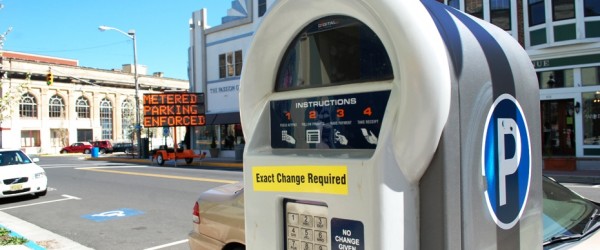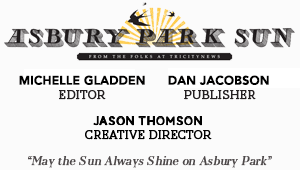Parking consultants divulge study findings, get feedback
Will present final recommendations early next year
Representatives from Desman Associates, the firm hired to study parking in the city, presented their findings to the public before they opened the floor to comments and questions Tuesday night.
Splitting the city into three main zones, the waterfront, Central Business District [CBD] and Main Street, Greg Shumate, a senior associate at Desman, outlined the conclusions of the firm’s survey, conducted between late July and mid-August. Since then associates have met with developers, city officials, business owners and others to gain input. The firm has also done work in Red Bank, Ocean City and Atlantic City.
In downtown Asbury Park in the daytime, there is not a shortfall of spots but rather a lack of convenience, whereas at night especially on weekend nights the activity rises well above the threshold. Researchers noted minimal space turnover along Cookman Avenue, which could hinder retail patronage. Desman may suggest when they present their final recommendations in late January or February that the city enact a two- to three-hour limit on those spots during normal business hours. Just a block away, however, the Bangs Avenue parking garage — where the city offers free parking Saturday nights — is largely underutilized. Along with a slew of empty spots, researchers found the cars that do use the garage are “pretty dusty and have been there a long time,” said Shumate. “It’s more like a storage facility.”
On Main Street, from Deal Lake Drive to Cookman Avenue, there is “a good balance of supply and demand” and finding parking is not difficult, Shumate said. There are no painted lines to mark off spots so street parking is free. Consultants suggested metered spots could bring order, organization and balance to parking there.
Along the waterfront, whether the city will ever be able to provide enough parking during peak summer season is unlikely, but there is a good amount of “natural turnover” to accommodate drivers, Shumate said. Researchers noted four different groups of people that frequent the beach area in the summer, they are the early morning patrons, lunch crowd, afternoon crowd, and the later dinner and party crowd.
“There is a lot of activity and it does seem to work relatively well,” Shumate said, adding the impact does affect neighboring communities and they are looking for solutions to that problem.
“The good thing is: you’ve got a parking problem. The bad thing is: you’ve got a parking problem,” said Tim Tracy, executive vice president at Desman.
About 50 people attended the meeting to provide their viewpoints.
One CBD resident who purchased a year-long pass to park in the city’s designated spots close to his home said when he returns after a late work shift, he is forced to ride around the block while he waits for a spot to open, but a mere one or two blocks away — in another zone he does not permitted to park — he stares at empty spaces.
Another found charging from 9 a.m. to midnight seven days a week, no matter the season, unconscionable.
Ideas Desman may propose to mitigate those situations include a tiered pricing program, Tracy said. Residents who choose one of the upper tiers would pay more for the convenience of being able to cross zones, he said.
In addition, the final report could suggest paid parking times and costs for metered spots fluctuate by season and relative distance from the desired location, Tracy said.
Sam Chung, co-owner of MOGO Korean fusion tacos, said he lived in the city prior to the implementation of metered spaces and while the spaces have helped with turnover, there is still a a low turnover rate. He also stated metered parking during lunch hours may be hindering a potential downtown lunch crowd as workers may want to drive into the city but only have an hour to spare and don’t want to lose time dealing with the paystations.
Ken Roth, who volunteers with the city’s chamber of commerce, said the city’s rail line is also underutilized and suggested a trolley to shuttle visitors back and forth from the transportation center to areas in the city could reduce impact.
The report will also take into account future parking needs as redevelopment continues.
Potential development in the Central Business District will produce a need for 1,158 spaces. Those spaces include 598 spaces to accommodate 398 residential units, 141 spaces for additional retail opportunities, 222 for restaurant opportunities, 9 for office spaces, and 333 spots to meet weekend theatre-goers needs for the proposed Savoy Theatre restoration.
Along the city’s waterfront, potential redevelopment puts the city at a dearth of 1,125 spaces. Over 4,860 will be required but redevelopers will provide on-site spaces for tenants as buildings go up and plan to construct two 200- and 400-car garages along Ocean Avenue.
City officials are looking forward to what consultants will ultimately propose.
“I think we are well on our way to getting some concrete recommendations that can be implemented, and if we follow those recommendations I feel that we will have a greater availability of parking and a more user-friendly parking experience,” said city Planning and Redevelopment Director Don Sammet.
“I’m looking forward to continuing to meet with Desman and reading their report, which is going to provide us with comprehensive, practical parking plans,” said Councilwoman Amy Quinn, who is a member of the parking committee.
————————————————————
Follow the Asbury Park Sun on Facebook, Twitter and Instagram.















